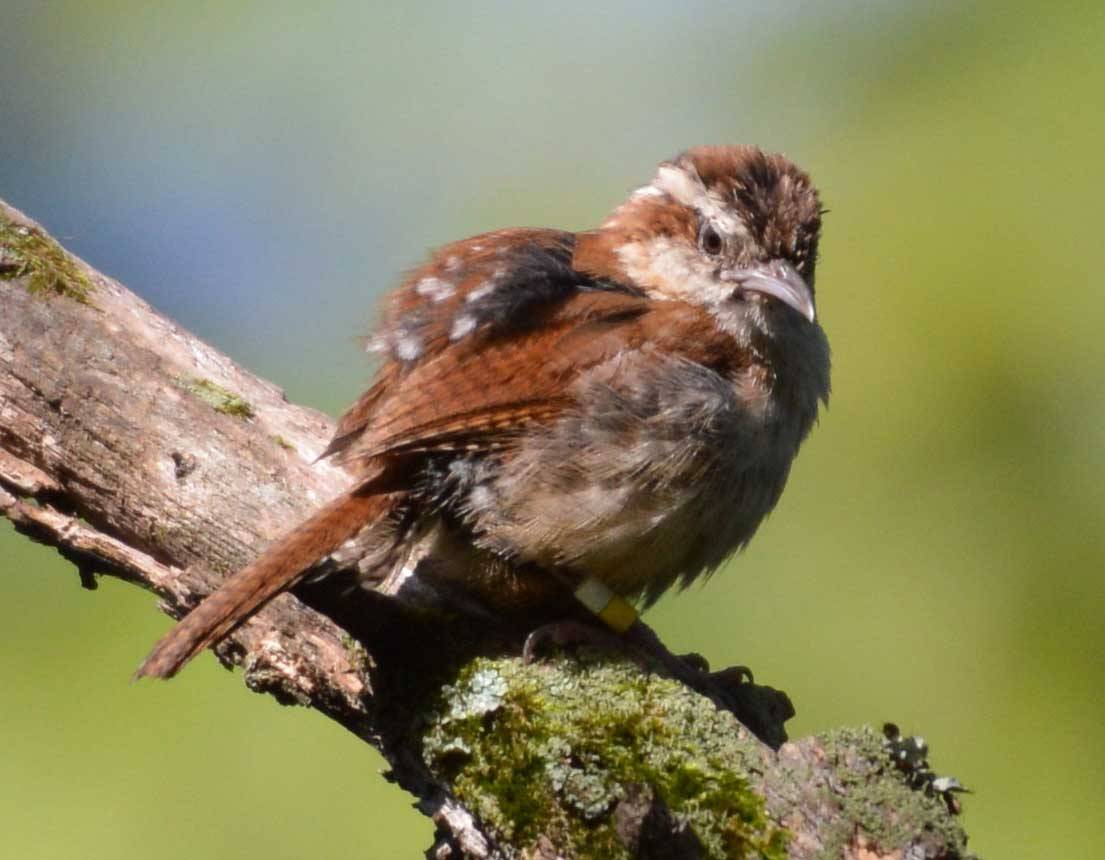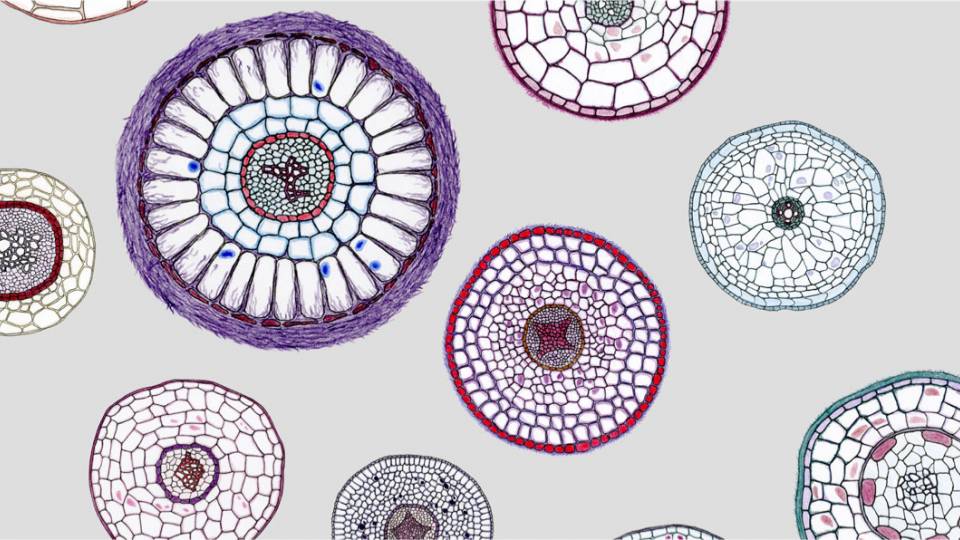Princeton seniors Katherine Irelan (left) and Willow Dalehite conducted fieldwork for their senior thesis research with support from the Becky Colvin Memorial Award presented each spring by the High Meadows Environmental Institute (HMEI) and the Department of Ecology and Evolutionary Biology.
Princeton senior Katherine Irelan spent two months in summer 2021 walking the slopes of Hawaii Volcanoes National Park searching for specimens of the native shrub pūkiawe (Leptecophylla tameiameiae) for her senior-thesis research on how the plant allies with soil fungi to thrive in different environments and climates. Her work was inspired by the element of nature that has always captivated her the most, namely, as Irelan said, “how things relate to one another, and in these really intricate and complicated ways.”
That same summer, Willow Dalehite combed different woodlands around Princeton listening for the call-and-response mating song of the Carolina wren, which she describes as “little and brown, with a pretty severe white eyebrow.” Carolina wrens are difficult to spot in the forest, but Dalehite was able to take advantage of their loud calls to locate them for her senior-thesis research investigating the evolutionary function of their song. “Their song is very loud for such a small creature,” she said. “It echoes through the forest, which makes it easier to follow them around.”
Irelan and Dalehite both conducted their research with support from the Becky Colvin Memorial Award, which is presented each spring by the High Meadows Environmental Institute (HMEI) and the Department of Ecology and Evolutionary Biology (EEB). The award provides juniors concentrating in EEB or in HMEI’s Certificate Program in Environmental Studies with support for travel, research supplies, and other expenses associated with field research for their senior thesis.
The underground alliances that help plants adapt
Irelan has always been fascinated by plants and passionate about climate change, but her interests coalesced when she visited the Amazon rainforest in high school. “The experience was really important in terms of recognizing that this was what was important for me to do with my life,” she said.
While at Princeton, Irelan became aware of the possibility that, at a certain tipping point, the Amazon might flip from being a rainforest to a savanna. “It was something that stuck in my brain, the concept of the Amazon just all of a sudden becoming a completely different ecosystem,” Irelan said. “I wanted to know what ecological processes were contributing to this flip.”
At Princeton, Irelan pursued her curiosity about how plants respond to climate shifts, and how these responses might in turn shape the changing climate. There are feedback mechanisms between larger climate shifts and individual plant responses that also are influenced by interactions with symbiotic fungi, Irelan said.
“Symbioses between plant roots and fungi are foundational to the evolution of plants on Earth,” said Lars Hedin, Irelan’s adviser and Princeton’s George M. Moffett Professor of Biology and professor of ecology and evolutionary biology and the High Meadows Environmental Institute. “There is so much we do not know about this mysterious collaboration between two very different organisms.”

Irelan worked in Hawaii Volcanoes National Park collecting specimens of the native shrub pūkiawe (Leptecophylla tameiameiae) (right) to examine how the plant allies with soil fungi to thrive in different environments and climates. She worked at the University of Hawai’i at Hilo staining certain root samples blue (left) to visualize fungal structures within them and quantify the fungal material associated with each plant.
Hawaii Volcanoes National Park was the perfect place to study these complex interactions because there is a natural rainfall gradient across the park — some regions experience heavy rainfall while others are very dry. This allowed Irelan to collect and compare the roots and surrounding soil of plants growing in regions of low, medium and high rainfall, which simulates how plants grow in drought and non-drought conditions.
Irelan worked in the laboratory of Rebecca Ostertag at the University of Hawai’i at Hilo staining her root samples blue to visualize fungal structures within them and quantify the fungal material associated with each plant. Other sections of the roots were set aside for genetic analysis — there are many visually indistinguishable species of symbiotic fungi that only genetic analysis can differentiate
It’s possible that certain fungal species are more common in different environmental contexts, and that different species confer different benefits to their host plant, Irelan said. Knowing the species of fungi that are most useful could, in certain contexts, have important applications for agriculture and conservation because these species could be disseminated to help plants thrive under otherwise hostile conditions.
“Katie’s project addresses a deep mystery about how plant communities persist in nature in the face of natural and human-induced disturbances,” Hedin said. “Her independence, intrepidness and good judgement were central to the success of her project, and she has emerged as an independent scientist who can design rigorous and important research projects.”
After her field experience, Irelan feels prepared and inspired to put her ecological research skills to work. “I feel like I am beginning to come into my own as a scientist,” she said. “I am excited to build on this experience in the future to try to improve the way that humanity interacts with the natural world.”
Up at dawn tracking 'tea-kettle' wrens
“We’d leave when the sun was rising because the birds wait for no one — they get up with the sun,” Dalehite recalled of her summer tracking Carolina wrens at field sites around Princeton, including Institute Woods near campus and The Watershed Institute in Pennington, New Jersey.

Dalehite investigated the evolutionary function of the call-and-response mating song of Carolina wrens (pictured), combing woodlands near Princeton’s campus as the sun was rising to record their songs. She focused on how a special type of vocalization known as “duetting” might strengthen pair bonds.
Growing up in central Texas, Dalehite had been a bird and nature lover since childhood when she would regularly go birdwatching with her mother. “I’ve been interested in studying ecology for a really long time because I’ve always had this love and interest in the natural world,” Dalehite said. “I also find birds really charismatic — they’re just fun.”
Dalehite’s interests in ornithology and behavioral ecology led her to start working with Christina Riehl, assistant professor in ecology and evolutionary biology and associated faculty in HMEI, during her sophomore year. Last summer, however, was Dalehite’s first chance at field work due to the coronavirus pandemic. She worked with EEB Ph.D. candidates Maria Smith and Trey Hendrix to catch wrens using mist nests in order to collect blood samples, take measurements and apply leg bands before releasing the birds.
Dalehite planned to focus her senior thesis on the wrens’ breeding habits and how food is allocated to nestlings — themes she had studied in the bird species greater ani as an HMEI Environmental Intern in Riehl’s lab in 2020. But her plans changed when she got into the field. “We found out pretty quickly that summer 2021 was not a good year for wrens, because the previous winter had been pretty cold,” Dalehite said. “Cold is one of the primary causes of mortality in wrens, so we didn’t find a lot of nests.”
She pivoted to focusing on the social dynamics of pair bonds and, in particular, how a special type of vocalization known as “duetting” might strengthen these couplings.
As one might guess, duetting refers to when a male and female wren sing simultaneously, except the birds don’t sing the same tune. A male wren begins a duet by singing a lilted and repeating phrase — which sounds like “tea-kettle, tea-kettle, tea-kettle” — and the female wren chimes in with a trill or chatter call.
There are several hypotheses as to why Carolina wrens duet. Some researchers think that it could serve as a territory defense, while others think it could function to reinforce pair bonds. These little birds are fiercely monogamous — males and females form pairs that can last several years. Being in a pair bond and being able to defend a resource-rich territory are both very important for wren survival, especially during the winter, Dalehite said.
“If territory is so important to your survival, then behaviors that can lead to the successful maintenance of the territory, and not getting ousted by other birds, would be adaptive,” Dalehite said. “It’s possible that the structures of social monogamy can contribute to territory maintenance, and one mechanism might be these duetting vocalizations.”
Dalehite tracked wrens through the forest and recorded their songs. She then converted these audio recordings into spectrograms that allowed her to visualize the frequency and duration of duets, as well as how synchronized male and female songs are. She is now analyzing these songs to investigate whether the age of a pair bond is associated with certain characteristics of the duets, such as synchrony.
As a researcher, Dalehite stood out for her creativity and independence, said Riehl, who was Dalehite’s thesis adviser: "I was absolutely blown away by Willow’s enthusiasm and intellectual maturity. I’ve met a lot of outstanding students at Princeton, but Willow is one who I know will go on to do great things in her career, both at Princeton and beyond."
After getting a taste of fieldwork, Dalehite is eager to continue exploring ornithology and behavioral ecology. “Fieldwork is probably one of my favorite parts of ecology now,” she said. “It was just really fun to get to spend so much time in nature every day.”







